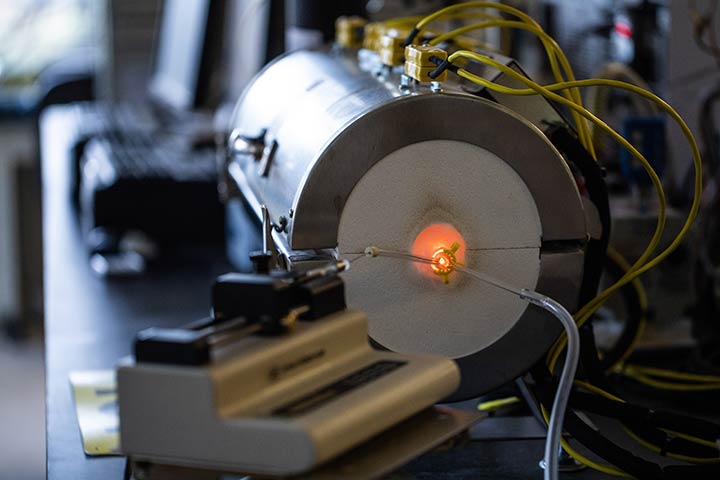Combustion Mechanism and Kinetics
NREL works to better understand engines as complex chemical reactors. The mechanisms and rates of the reactions occurring are critical to how fuel chemistry affects engine performance. Therefore, our research directly reveals chemical structure effects that can be leveraged for higher efficiency and lower pollutant emissions.
Autoignition and Soot Formation Mechanisms from a Laminar Flow Reactor

For development of accurate kinetic simulations, NREL is using a laminar flow reactor to study mechanisms of fuel autoignition and soot precursor formation by quantification of stable intermediates. The reactor consists of a:
- System for metering gases and fuels
- Quartz tube in a high-temperature furnace
- Gas sampling and analysis system.
The reactor operates at 1 atm (standard atmosphere) and temperatures up to 1,200 kelvin.
Fine particle emissions (soot) from gasoline combustion have become a limiting factor for high efficiency, direct-injection spark-ignition engines. A recently developed predictive model of molecular structure effects on soot formation failed to predict soot formation for three positional isomers of methylcyclohexene, pointing to new or unusual reaction chemistry not captured by the model.
An NREL combined flow reactor experimental and theoretical study demonstrated that 1-methyl-1-cyclohexene and 4-methyl-1-cyclohexene preferentially react via ring opening and molecular weight reduction. 3-methyl-1-cyclohexene, which produces much higher soot, preferentially reacts via dehydrogenation to cyclic dienes—consistent with higher soot formation. The relative stability of the first radical intermediate was shown to determine the branching ratio between formation of soot precursors and ring opening retro-Diels-Alder reaction products.
We also have applied results from the flow reactor to development of an experimental approach to predicting research octane number (RON) using very small quantities of a candidate fuel.
Our ongoing research is examining autoignition reaction mechanisms for spark-ignition engine blendstocks identified under the Co-Optimization of Fuels and Engines initiative.
Related Publications
Screening Fuels for Autoignition With Small Volume Experiments and Gaussian Process Classification
Experimental and Theoretical Insight into the Soot Tendencies of the Methylcyclohexene Isomers
Ignition Delay in a Constant Volume Device
While NREL has been developing constant volume devices for rapid ignition delay measurements for many years, recent efforts have focused on improving the homogeneity of the fuel-air mixture and on quantifying the degree of mixing using computational fluid dynamics (CFD) simulations. A commercial device, the Advanced Fuel Ignition Delay Analyzer (AFIDA), has been used as the starting point for development of this experiment.
NREL's experiment uses a piezo-electric diesel injector with a maximum pressure of 1,200 bar to achieve improved and rapid mixing of fuel and air after injection. A CFD simulation of the experiment shows excellent temperature and composition homogeneity with in ~30 ms of fuel injection, where a simple 0D simulation can be used to satisfactorily predict ignition delay times.
For shorter ignition delay times, the developed CFD model has been shown to accurately separate the chemical and physical effects. The instrument can provide high-quality ignition delay measurements, especially for the critical low-temperature and negative temperature coefficient ignition regions. An experimental technique has also been developed for the AFIDA to rapidly predict RON and range of octane sensitivity (OS = RON minus motor octane number, MON) for small fuel quantities.
Related Publication
Contact
To learn more about our work or explore partnership opportunities, contact Gina Fioroni or Brad Zigler.
Publications
NREL researchers publish journal articles, conference papers, and reports about combustion mechanism and kinetics R&D.
Share
